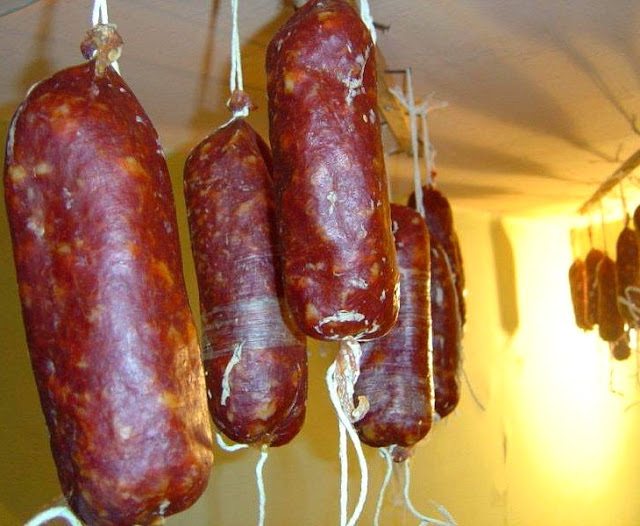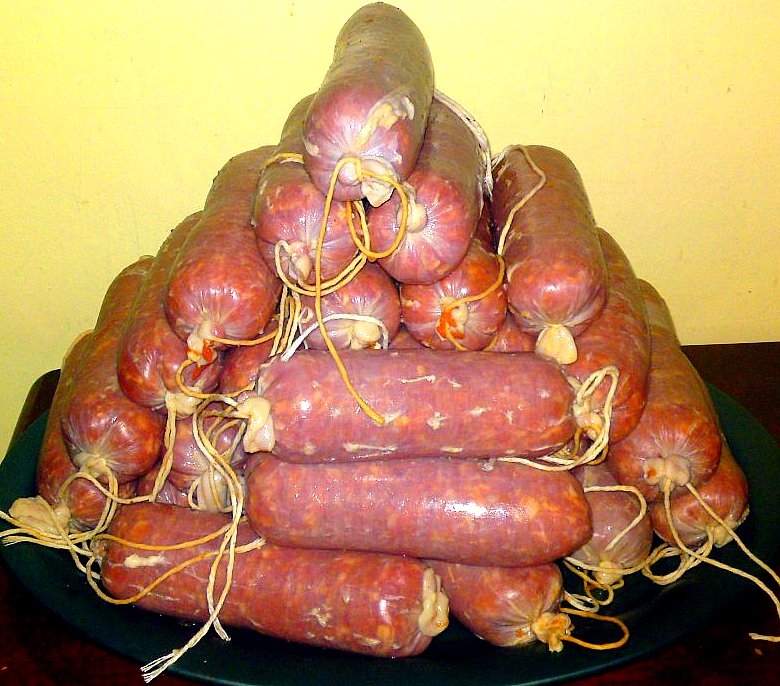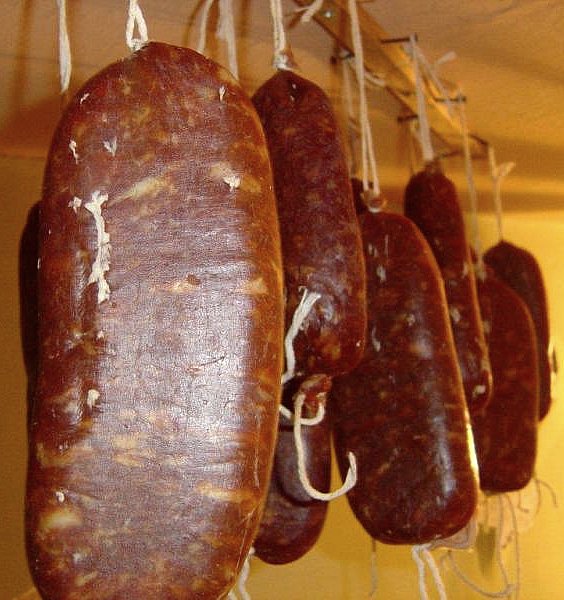Pennsylvania Salami Makers: Homemade Soppressata or "Soupie"


(Photo "Soupie" or Soppressata during the "first hanging." The meat is already starting to shrink and change color; the meat hangs in this manner for one week. Courtesy of Matt Scicchitano)In Calabria, the salumi sopressata (see my guide to salumi) enjoys PDO or Protected Designation of Originstatus meaning any salami labeled as Sopressata di Calabria must be entirely manufactured (prepared, processed AND produced) within the specific region according to traditional methods. Sopressata received its name from the practice of pressing the salami between pieces of wood resulting in a straight, flattened shape (click here for more articles on salumi and charcuterie).
Travel a little over 5000 miles west to the coal regions of central Pennsylvania and you'll encounter another community intent on making world class Soppressata or "soupie" as they refer to it in coal country. According to Matt Scicchitano, a Scordo.com reader, third and fourth generation Italian Americans produce soupie every year right around the first of January. Completely unaware of the aforementioned tradition, I'm posting Matt's wonderful description of both the soppressata / soupie making tradition in central Pennsylvania and his vivid photos.

(photo: Scicchitano and his oldest son, Sal, getting the hang of cranking the grinder/stuffer. Courtesy of Matt Scicchitano)

(photo: "soupie" or Soppressata ready to dry for a week before being pressed, notice the great work with the string <this is a critical step so that the meat doesn't escape the casing. Courtesy of Matt Scicchitano)


(Photo: The equipment used to press the soupie in order to give it it's unique shape. The meat is pressed for 3-4 days using about 400 pounds of pressure Coutesy of Matt Scicchitano)The "coal region" is a span of central PA that was made popular back in the 1800's/early 1900's due to the enormous amounts of anthracite coal found in the area. Pair that with the global need for coal as an energy source at the time and it's easy to see how our area became popular very quickly. Hundreds of thousands of immigrants flocked to this area during that time because of the demand for cheap labor from the coal companies, and among those immigrants was a large percentage of southern italians, specifically Calabrese. This area became a melting pot of ethnic foods and customs from Italian to Irish to German to Polish and many others. Unfortunately many of the traditions are disappearing, if they haven't disappeared already, but one tradition that is very much alive and well is making "soupie".
The specific area of the coal region where I am from (the western end, made up of towns like Mount Carmel, Kulpmont, Atlas, Shamokin, Locust Gap, etc) not only had a large amount of Calabrese immigrants, but specifically from one small village in Calabria called Isca (Isca is located on the easter side of Calabria, along the Mediterranean and Ionian seas). This is where our beloved soupie came from and was one of many foods that were brought over and remained a strong part of the italian communities in our area, though it is one of the last that still remains popular. It is so popular, in fact, that many of the younger generations really have no idea when or where it came from or even that it's "Italian." They only know that their dads and/or uncles made it, and their dads and uncles before them, and if anything, it is a "coal region" thing and it is made by everyone in this region, not just those with Italian heritage.
In our family, my wife and I are the soupie makers (with help from my dad), however many men get together with friends/brothers/cousins for soupie weekends where cellars and garages throughout the coal region take on an almost "superbowl" atmosphere, usually with plenty to eat and drink. Women are not usually among those involved in making soupie in our area.
Each group of guys have their own "secret ingredient" or a secret ratio of the main ingredients(salt, pork, some form of red pepper), and of course, everyone's are "the best." This thinking among soupie makers in our area has spawned "soupie bowls" which are basically taste testing contests to see whose soupies are the best. Many businesses and local news stations have become part of the anual contests and have even expanded to include pasta dishes and homemade wine in the judging.

(Photo: Soupie back up for a second and last hanging. They are flattened out quite a bit already, but will shrink/flatten even more as they continue to dry. Depending on the weather, they will usually hang for about four weeks like this. Courtesy of Matt Scicchitano)

(Photo: Soupie ready to be consumed. The rule of thumb, according to Scicchitano, is that you put them in oil after they are done hanging and wait until the first ripe tomato from the garden to eat the first soupie of the season (we never wait that long!). Courtesy of Matt Scicchitano)
I learned how to make soupie years ago by a great woman who was born and raised in Isca (also where my family is from) and she not only showed me how to make them with great detail, but explained why her family made them, how they raised their pig and what it meant to have it so they could cure it's meat and contine to live off of it for months to come. How she would stuff the casings with the ground pork with nothing but her thumbs. It gave me a great deal of pride and respect for our soppressata that my own family makes, not because we need it to survive anymore, but because our great grandparents and everyone before them did.
My wife and I are currently building a house and we spent an hour talking with the builder on where we could put vents/windows to have cross ventilation so we could hang our soupie. The builder never heard of them and was amazed that I would put so much importance on this seemingly minor detail but as I explained to him in great detail about supressata and what it means to us, he was as determined as I was on getting the ventilation right(which we did).
Thanks for the great story, Matt!
Scordo.com - a practical living, how to, food, and personal finance blog.
Comments
anonymous
There’s no recipe
Matt
Where's the recipe